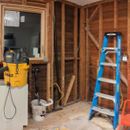Kitchen wallboard choice in Bay Area, CA
We are remodeling a kitchen in a 1920s (maybe even 1900s) house in the bay area (94402, climate zone 3C I think). Historically this house had no insulation in the wall cavity. We are adding 3.5 inches of mineral wool. There will be subway tile backsplash above the countertops to the ceiling. What type of drywall or cement backer board is advisable? The candidates are
1) 5/8″ Moisture resistant gypsum board (Gold Bond XP)
2) 5/8″ DensShield (glass-faced gypsum board)
3) 5/8″ Durock concrete board
I like the DensShield option best except that it’s vapor semi-impermeable (1.5 perm), which I worry could cause condensation in the wall cavity during the summer. An NAHB tech note[1] indicates a “Interior vapor retarders are not necessary in 2B, 3B, and 3C” but doesn’t say to avoid them, as it does for zone 3A (“Interior vapor retarders should be avoided to allow drying to the indoors”). FWIW, we rarely run AC here but run heat for 3 months of the year.
Drywall only seems to be acceptable as a tile backer for “res1” conditions according to “TCNA Handbook for Ceramic, Glass, and Stone Tile Installation.” I’m not sure if a backsplash is res1 or res2 per the below definitions and internet searches:
> Res1 (Residential Dry): Tile surfaces that will not be exposed to moisture or liquid, except for cleaning purposes. Includes areas adjacent to R2 areas. Examples: Floors in rooms with no direct access to the outdoors and no wet utility function, such as living rooms, dining rooms, and bedrooms; dry area ceilings, softs, decorative/accent walls, freplaces, some backsplashes and some wainscots.
>
> Res2 (Residential Limited Water Exposure): Tile surfaces that are subjected to moisture or liquids but do not become soaked or saturated due to the system design or time exposure. If waterproofng is desired, it must be clearly specifed. Includes areas adjacent to R3 areas. Examples: Floors in bathrooms, kitchens, mudrooms, laundry, and foyers, where water exposure is limited and/or water is removed; some backsplashes, some wainscots, some countertops.
[1] https://www.iccsafe.org/wp-content/uploads/proclamations/TN06-Vapor-Retarders_pdf.pdf
GBA Detail Library
A collection of one thousand construction details organized by climate and house part










Replies